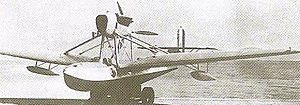Savoia-Marchetti p.67
| Savoia-Marchetti p.67 | |
|---|---|

|
|
| Type: | Flying boat |
| Design country: | |
| Manufacturer: | |
| First flight: |
January 28, 1930 |
| Number of pieces: |
3 or 4 prototypes |
The Savoia-Marchetti S.67 (also SIAI S.67 ) was a monoplane flying boat that was developed in 1929 by the Italian manufacturer SIAI . The Regia Aeronautica had advertised a catapult capable flying boat that was to be used as a fighter and reconnaissance aircraft for warships.
history
The S.67 was a monoplane flying boat that was supposed to take off from the Regia Marina's new Condottieri cruiser class with the help of a catapult. The machine had to be compact and the wings had to be foldable. Six men should be able to move the machine from its stowed position to a ready-to-fly position within five minutes. The machine had an open cockpit and two Vickers -7.7 mm machine guns as armament . The tried and tested Fiat A 20 engine with 520 hp with a two-bladed propeller was provided as the engine . The first test flight of the SM S.67 with test pilot Alessandro Passaleva took place on January 28, 1930 near Sesto Calende and was successful, so that the machine could be handed over to the Centro Sperimentale in March 1930 for further testing . Their test pilot Alberto del Prete crashed in April of the same year with the plane. The Regia Marina nevertheless commissioned three more aircraft, which were delivered by January 23, 1932. However, according to another source, only two more machines were built. One of the three post-produced flying boats, the MM 144, crashed during a stress test on October 19, 1932. After the project was discontinued, the two remaining S.67s were incorporated into the 162 ° Squadriglia of the 88 ° Gruppo of Aeronautica Militare and used there until April 1935.
construction
The S.67 was a pure wood construction that was reinforced with metal at the particularly stressed areas. After the crash, the two-bladed propeller used was considered a weak point and it was replaced with a stronger three-bladed metal propeller, but without any improvement. As requested by the Regia Marina, the wings of the machine could be dismantled with screws and reassembled in 30 seconds. This construction turned out to be the weak point in the tests and was probably the cause of the crash.
Technical specifications
| Parameter | Data |
|---|---|
| span | 13.10 m |
| length | 8.97 m |
| height | 2.90 m |
| Wing area | 27.2 m² |
| Empty mass | 1209 kg |
| Takeoff mass | 1639 kg |
| drive | a Fiat A 20 12 cylinder V-engine with 520 HP and two-blade propeller made of wood, later three-blade metal propeller |
| Climbing ability | 5.1 m / sec |
| Top speed | 258 km / h |
| Range | approx. 500 km |
| crew | 1 |
| Armament | two 7.7 mm Vickers machine guns (.303) |
Individual evidence
- ↑ SIAI p.67 (Fighter A to Z) . In: AIR International December 1992, p. 343
Web links
- Documentation on page 67 with pictures (Italian)